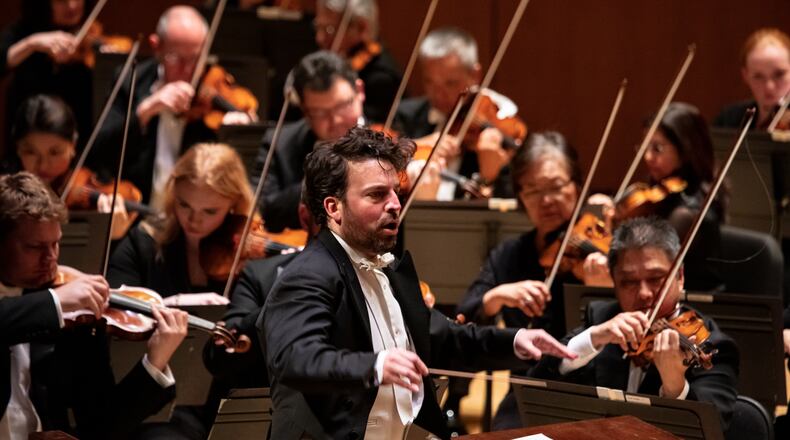“Starburst,” a 2012 composition for string orchestra by Jessie Montgomery, is the perfect encore: It’s a quick burst of sound (around three minutes long) that has an undeniable, underlying groove but also serves as an example of virtuosic ensemble playing.
After leading the Atlanta Symphony Orchestra through an animated “Starburst” on Thursday at Symphony Hall, guest conductor James Gaffigan puckishly turned to the audience. “How did you like it?” the conductor, who last led a significantly different ASO in 2013, hollered to applause. “Good. Because we’re going to play it again.”
From the first notes, and the resulting repeat of the entire work, Gaffigan flaunted an unbridled enthusiasm for Thursday’s program. He also showed an exacting dedication to music making. Throughout the composition, strings pulsated and throbbed. In hushed sections, ruddy pizzicato from the cellos maintained the forward propulsion as wispy, delicate strings floated over top.
Gaffigan next turned to Beethoven’s first symphony. Written before the composer lost his hearing (or as Gaffigan referred to the piece from the stage, “pre-grumpy Beethoven”), the symphony can sound a little, well, old – especially following a contemporary work. Conducting at times with his eyes closed, lovingly shaping phrases with cradled arms, Gaffigan brought out the tenderness and delicacy of Beethoven’s orchestration. As the music turned stormy, the ensemble didn’t round the edges of thunderous, booming passages, giving articulated notes a stalactite edge.
After opening with a “Starburst” joke, Gaffigan ended the program with a musical joke of another kind. Richard Strauss’ “Till Eulenspiegel’s Merry Pranks” is full of surprising juxtapositions, instrumental personifications and a general sense of gaiety. The ASO performed these puns with a light, carefree musicality, deftly traversing passages of cacophonous chaos and bombast with a bright, clear ensemble sound.
In Ralph Vaughan Williams’ oboe concerto, pastoral, verdant accompaniment from the orchestra supported Elizabeth Koch Tiscione’s solo voice with velvety sound. An accomplished member of the orchestra, Koch Tiscione coaxes a deep but shimmering grain from the notoriously adenoidal oboe. When she ascended to the upper reaches of her instrument, her sound amazingly took on a flute-like resonance. Gaffigan made sure the bucolic orchestrations, led by a lavish string section, remained hushed and supportive, but appropriately emphasized the teeming expanses of ensemble playing
Conducting can be a deeply athletic occupation, and on Thursday, Gaffigan used his entire body to convey musical direction. He crouched, bending his body down toward the podium when the musicians needed to play sotto voce. He did a split-second march-like jig toward the violins to create a lighter, danceable texture in the music. The fingers of his left hand either chopped or sculpted the air, then he sent his fingers fluttering to show the direction of a phrase. With the aid of a baton, his right hand kept lockstep time, keeping the orchestra on tempo.
Was Gaffigan’s performance a job interview of sorts? Gaffigan has announced that he’ll be leaving his position as chief conductor of the Lucerne Symphony Orchestra in Switzerland at the end of the 2020-21 season.
Less than two months from the unveiling of Robert Spano’s valedictory season as music director, there is little indication of what lies in store for the orchestra’s musical leadership. Next week, another potential candidate visits Atlanta, and a handful more guest conductors will visit the ASO in the coming months. Perhaps one of these guest conductors could be leading the ASO into the future?
CONCERT REVIEW
Atlanta Symphony Orchestra
8 p.m. Saturday. $29-$98. Symphony Hall, 1280 Peachtree St. NE, Atlanta. 404-733-5000, atlantasymphony.org.
About the Author
Keep Reading
The Latest
Featured

